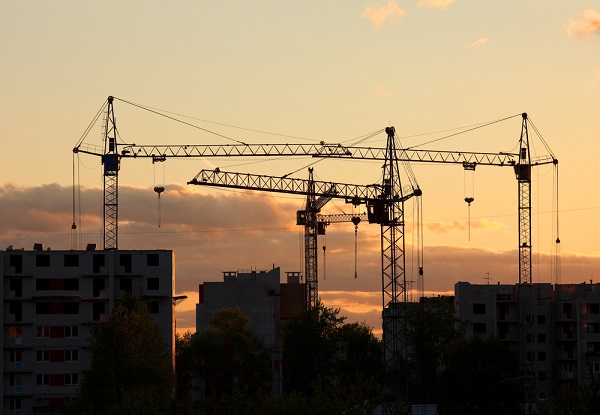Water, Wildfires Create Problems for Builders Risk Insurers

By: Jacquelyn Connelly
Overall, U.S. construction was up 7-8% in 2018 compared to the prior year, according to the U.S. Department of Commerce.
The National Association of Home Builders Market Index, however, dropped to 60 points in November from a reading of 68 points in October—marking the lowest score since August 2016, according to Willis Re.
But while those numbers reflect some slight slowing in the housing market, Willis Re notes that a score above 50 is still positive. “It may be below projections, but it’s still a very healthy housing market” for both detached single family and multiunit homes, points out Jeff Benson, builders risk program manager at Victor O. Schinnerer & Co.—“particularly in the South and the West, which is where people continue to move if you’re looking at population trends.”
That assessment appears to hold true for the U.S. construction industry in general. On the other side of the spectrum, in the large commercial construction space, “underlying fundamentals for our contractors seem to be very strong” as well, says Joe Vierling, senior vice president, AXA XL North American Construction Property. “We’re seeing a lot of building projects in all segments, from commercial office and real estate, from infrastructure projects to oil and gas projects. Our contractor partners appear to have good pipelines and a good backlog of business as they go forward.”
And ironically, none of that is great news for builders risk insurers. A booming construction economy combined with ample capital and capacity means pricing in the residential builders risk insurance space has been “very favorable to the project owner and contractor,” says Tyler Van Spanje, innovation leader for marine insurance at Vindati, an InsurTech MGA focused on the marine, construction and agriculture sectors of the small to midsize commercial insurance space.
Van Spanje expects rates to remain stable in 2019, barring a significant increase in interest rates, which could drive pricing even lower. Similarly, in the middle-market space, “pricing is still very competitive,” says Mike Perrotti, senior vice president, AXA XL inland marine practice leader. “We’ve seen broader terms and lower prices.”
However, “many carriers have experienced losses that have caught up with the rates,” Perrotti adds. “The expectation is that we will see more stable rates and even an uptick in rates in the near future.”
“The results have not been great for builders risk carriers overall, just because of where the pricing was,” summarizes Vierling, who notes that a number of European markets are starting to pull out of the market altogether. “You’re seeing a significant amount of capacity leaving the marketplace out of London, and that outflow could eventually translate into rate and deductible increases, depending on what perils and classes of business you’re looking at.”
What’s driving losses in a market where coverage continues to broaden?
1) Water damage. According to ISO data, water damage was the most frequent cause of loss during construction in 2017, accounting for nearly 28% of all claims. That’s by far the highest claims frequency, followed by theft at about 23% and fire at 8%. “Fire still remains the most severe from a loss dollar perspective and from an average claim perspective, but water damage is certainly not insignificant,” Perrotti says.
According to Alexander McGinley, senior vice president, marine, AXA XL, water damage claims started to increase significantly during the Great Recession. Today, “they’re becoming not only more severe, but also more frequent,” he says. “It’s really just part of the expectation in the underwriting process that you may have a water damage loss, whereas before, the primary focus was fire.”
“Getting back to the question of what’s driving some of these companies to leave the market, I believe water damage is a major contributor,” Vierling adds. “It’s really eroded the profitability of their books.”
As a result, expect “more questions from underwriters regarding how insureds are mitigating water risk,” McGinley warns. “Or, if pricing continues to erode, the insurance carrier may simply seek to mitigate that loss by having more stringent conditions—either a higher deductible or potentially a warranty to ensure a water damage prevention plan is in place.”
2) Wildfires. Recent years have thrown a few natural cat events at the insurance industry, but “they haven’t really shifted the needle” for builders risk, Van Spanje says. Wildfires, on the other hand, “are such an unknown. We’ve had them over the years with California in particular, but this is a whole new ballgame, and I think the entire industry from a property perspective is starting to take another look at those fire exposures throughout the West.”
“The growing regularity of high-severity fires along the West Coast is certainly something insurance carriers are keenly looking at, because at least for the last two years, it’s been the new normal,” McGinley agrees. “The losses have been quite substantial. In some ways, it actually creates an opportunity for builders risk insurance—buildings burn down, they need to be replaced. But if they’re going to be rebuilt in the same area, you’ve got to expect that loss is going to occur again.”
Naturally, “some markets may not be willing to insure that,” McGinley points out. “If you’ve got a frame building that burned down in a Protection Class 9, there aren’t going to be many takers who want to rebuild it. Or, the terms and conditions may be so stringent that the insured may just decide to self-insure.”
Van Spanje expects wildfires to eventually impact pricing across all property markets, including builders risk. Assuming insurers don’t pull out altogether, “there might be a slight firming because of wildfires,” he says. “There’s already been a shrinkage of capacity in the wood frame marketplace over the last five years. Everyone’s evaluating their property exposures and portfolios in those potentially fire-exposed areas.”
Jacquelyn Connelly is IA senior editor.










